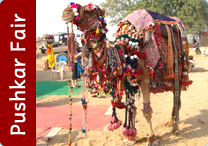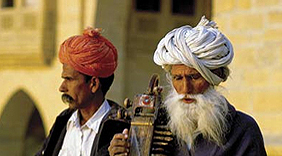
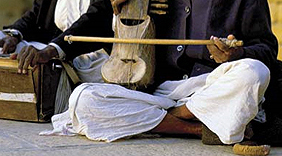

Custom Made Tour
Feel free to let us know if you are looking for customize tour program as all the tour itinerary is sample it can be modify according to your requirements.
Home - Rajasthan Travel Guide - Jodhpur Tour
Jodhpur Tour
History of Jodhpur
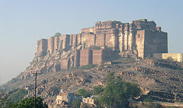
Jodhpur the second largest city of Rajasthan has been drawing the notice of tourists from all over the world. Standing as the guard of the country's western border, Jodhpur is famous for its magnificent forts and palaces all over the world. Some of the area of great Indian desert THAR also comes with this district towards west. Extreme of heat in summer and cold in winter is the characteristics of the desert and Jodhpur is no exception of it. The city is like a haven in the vast desert, with a variety of difficult shrubs all over the area. It also has some of the animal species that can stay alive in an arid and dry environment and with no perennial river in the district.
Today’s Jodhpur is only a small portion of the grand Marwar state before independence. Today The city of Jodhpur prospered because of its location on the strategic Delhi - Gujarat trading route and today stands out as one of the more well-liked cities visited in India and is one of many in the country where a number of luxury hotels, restaurants, good Shopping centre, Export Houses and having all good connectivity to all the major cities by, train, air and road. Now a days Jodhpur has again boast a first class grass polo ground that will produce the next generation of international Jodhpur players and may host potential Indian and International polo games which will be proud of India.
 Charming palaces, forts and temples spread throughout the city bring alive the historic greatness of Jodhpur. A passionate angle to this unique place is its superb handicrafts, folk dances, folk music and brightly attired people. Jodhpur famous for lot of festivals brings out the festive spirits of the people of this city. The market of Jodhpur includes a wide range of goods from tie & dye textiles, embroidered leather shoes known as Mojris, antiques, carpets and puppets to the wonderful Rajasthani textiles, clay porcelain, marble inlay work, classic silver and golden jewellery and much more makes hot spot for national and International trading. It is very difficult to give trading information of remote area of Rajasthan which is unique in the whole world on national and International level.
Charming palaces, forts and temples spread throughout the city bring alive the historic greatness of Jodhpur. A passionate angle to this unique place is its superb handicrafts, folk dances, folk music and brightly attired people. Jodhpur famous for lot of festivals brings out the festive spirits of the people of this city. The market of Jodhpur includes a wide range of goods from tie & dye textiles, embroidered leather shoes known as Mojris, antiques, carpets and puppets to the wonderful Rajasthani textiles, clay porcelain, marble inlay work, classic silver and golden jewellery and much more makes hot spot for national and International trading. It is very difficult to give trading information of remote area of Rajasthan which is unique in the whole world on national and International level.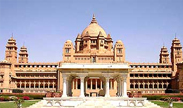
Regarding the Jodhpur culture, the Jodhpuri people are amongst the most hospitable people of India. They have a typical Marwari accent. The lifestyle in Jodhpur, India is quite fascinating. The folks there wear nice and lovely multihued costumes. The women folk wear wide gathered skirts and a hip length jacket, with three quarter length sleeves, covering the front and back. Women are also love to wear jewelry on many parts of their body. They particularly like to wear specific type of jewelry like the ones worn on the feet, head, forehead, ear, nose, neck, arms, wrist, fingers, waist, etc. Another one of the unique features of the culture of Jodhpur, Rajasthan is the colorful turbans worn by men. The popular tight, horse riding trousers, 'Jodhpurs', took their name from this city only. The main languages spoken here are Hindi, Marwari and Rajasthani.
The graceful palaces, forts and temples strewn throughout the city bring alive the historic grandeur of this city. Lending a romantic aura to Jodhpur, are its exquisite handicrafts, folk dances, folk music and the brightly attired people. The desert people are quite affable. With their sweet smiles and warm hospitality, they win the hearts of the tourists. The famous Marwar festival brings out the festive spirits of the people of this city. The bazaars of Jodhpur have a range of items from tie & dye textiles, embroidered leather shoes, lacquerware, antiques, carpets and puppets to the exquisite Rajasthani textiles, clay figurines, miniature camels and elephants, marble inlay work and classic silver jewellery.
How to Reach Jodhpur
By Air : The Jodhpur Airport is 5 km from the city center. Regular flight services connect the city with other major cities in and around Rajasthan. There are daily flights to Delhi, Mumbai, Udaipur and Jaipur. By Train : Jodhpur is well connected by railway lines. Trains to Delhi, Mumbai, Chennai and Kolkata are easily available.
By Train : Jodhpur is well connected by railway lines. Trains to Delhi, Mumbai, Chennai and Kolkata are easily available. By Road : Another convenient mode of transportation to Jodhpur is by road. The main highway between Jodhpur and Jaisalmer is via Agoli and Pokaran. The highway is well connected with Agra, Ahmedabad, Ajmer, Delhi, Jaipur, Jaisalmer and Udaipur by bus.
Local Transport : Means of transport in Jodhpur include Taxis, Auto-rickshaws and Tongas. Taxi stand is near the main railway station. Auto-rickshaws are best suited for the narrow lanes of the old city. You can also explore Jodhpur with a bicycle.
Jodhpur General Information
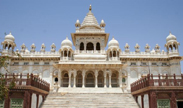
Population : 10,64,743 (2001) Area: 75.50 sq. km.
Altitude : 230 m (above sea level)
Temperature : Summer Average Max 42.2°C, Average Min. 27.3°C Winter Average Max. 27.5°C Average Min 9.5°C
Rainfall: 318.10 mm
Season : September to March
Clothing : Summer - Light Tropical Winter - Light Woolen
Languages : Hindi, Rajasthani & English
PLACES OF INTEREST ARE:
Mehrangarh: One of the most stunning hill forts of Rajasthan, Mehrangarh appears to rise from the bluff-coloured sandstone hill itself, so well built into the base that it is difficult to tell where the hill ends and the walls begin. Founded in the 15th century by the Rathore Rajputs when they shifted their capital form nearby Mandore to Jodhpur (or the region known as Marwar), it is approached by a series of seven gateways set at an angle so that armies could not charge them with any success. Pass the gates, the fort-palace take one's breath away. Across form huge courtyards are set wings of palatial apartments that have been built over five centuries of bristling history. Today, managed as a museum by the royal trust that maintains it, only some of the more spectacular palaces of Mehrangarh are open to visitors. These consists of Moti Mahal with its pierced screen windows overlooking the coronation seat where the Rathore rulers have been ritually appointed to rule, Jhanki Mahal, the Apartment from where the zenana women would watch ceremonial events; Chandan Mahal, where affairs of state were discussed; the royal Darbar Takhat or throne room with its octagonal throne; and the Rang Mahal where the Maharaja would play Holi with his zenana. Also noteworthy are Sheesh Mahal, Phool Mahal, Umaid Vials and Maan Vilas, while a large ten seized from the Mughals in battle is spread for viewing in what has come to be referred to as the Ten Room. Mehrangarh from the outside is impressive, and certainly forbidding. There is a surprising lightness to it though, once actually within the fort. The builders seemed to want to make up for the stern austerity of its wall with an overwhelming profusion of windows and jharokas at the upper ends. The effect seems to exaggerate its already impressive height. Umaid Bhawan Palace: Umaid Bhawan Palace can qualify for several firsts: the largest private residence in the world, the finest extant example of art-deco, the only palace to have painting from the Ramayana painted by a Polish artist, the first to use air-conditioning, electricity and elevators, and the most impressive for its size and dimensions. Yet, that should be hardly strange, for the architect, H.V. Lancaster, who planned it, wanted it to rival the Vice Regal Lodge (now Rashtrapati Bhawan) then being planned by Sir Edward Lutyens in the new capital at New Delhi, also then under construction. For starters, Umaid Bhawan is a formal building that is perfectly symmetrical, and its 347 rooms offer few concessions to Rajput architecture other than such devises as concealed corridors and balconies for the women of the zenana, and the use of courtyards around which the several wings of the palace are arranged.
Umaid Bhawan Palace: Umaid Bhawan Palace can qualify for several firsts: the largest private residence in the world, the finest extant example of art-deco, the only palace to have painting from the Ramayana painted by a Polish artist, the first to use air-conditioning, electricity and elevators, and the most impressive for its size and dimensions. Yet, that should be hardly strange, for the architect, H.V. Lancaster, who planned it, wanted it to rival the Vice Regal Lodge (now Rashtrapati Bhawan) then being planned by Sir Edward Lutyens in the new capital at New Delhi, also then under construction. For starters, Umaid Bhawan is a formal building that is perfectly symmetrical, and its 347 rooms offer few concessions to Rajput architecture other than such devises as concealed corridors and balconies for the women of the zenana, and the use of courtyards around which the several wings of the palace are arranged.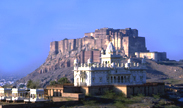
Jaswant Thada : A cluster of royal cenotaphs in white marble built in 1899 A.D. in memory of Maharaja Jaswant Singh II. Within the main cenotaph are the portraits of various Jodhpur rulers.


